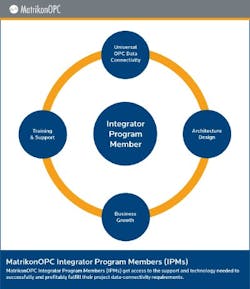Top Five OPC Questions Integrators Need To Ask
As the saying goes, there’s a fine line between success and failure. System integrators, who face the challenge of delivering projects that handle more information, give more functionality, faster and easier while being on time and budget, understand how fine the margin really is. While OPC connectivity should reduce system complexity and save project time, there is the potential for expectations and cost to go astray if certain project risks aren’t properly managed. There are important questions integrators need to ask and get answered to ensure the success of any major OPC implementation.5 ‘gotchas’ of OPC system interoperabilityEvery systems integrator has experienced some type of system connectivity problem on one project or another. While hindsight may build character, foresight makes project implementation go smoother and cheaper. The first step in asking the right questions is to understand the five most common roadblocks to successful system interoperability.1. Proper Architecture Design—There is more to reliably moving data throughout complex systems than just choosing the right products. Any OPC system architecture needs to consider aspects such as reliability, guaranteed data delivery, redundancy and recovery and what those mean in terms of OPC implementation.2. System Performance—End users always know what they want. Problem is they often don’t realize what they want until they see what they got. Connecting multiple vendor systems poses many choices in product deployment, speed of data throughput, tolerance to interruption, system loading and maintainability. System integrators need to ask the right questions to determine customer priorities in order to make the right tradeoffs in system design.3. Firewalls, Domains and Windows Security Settings—Operations security is top of mind for everyone, and Microsoft technology is a dominate feature in many industrial automation settings. Typical IT imposed security features such as firewalls, multiple isolated domains, DCOM and other Windows Security settings are the bane of many interconnected systems.4. Non-compliant OPC Software—Although the OPC Foundation provides much in the way of compliance and interoperability test tools, there are still vendors who put less than perfect product on the market. Unreliable, non-compliant or custom OPC products are risks that need to be recognized and handled in many system implementations.5. Multi-vendor Interconnectivity—The nature of system integration tends to produce generalists who have some knowledge of a large number of products from multiple vendors. This also means systems integration includes a substantial amount of diagnostic and troubleshooting work since most vendors have not validated their systems interconnectivity with rival products.The Top Questions?Knowing the problem is only half the battle. How does a system integrator ensure these issues don’t overwhelm their project? The answer is to ask the right questions.Question #1—What Is The Key Requirement of the OPC Architecture?The obvious answer would be to move data through the system, otherwise you probably wouldn’t be using OPC. Data movement is a function of the system, not the key requirement or goal of the architecture. Different users place different priority on different aspects of the architecture: reliability, robustness, guaranteed data delivery, security, specific data type accessibility or system loading. While all these various aspects need to be considered, the order of priority impacts the overall OPC system architecture.Question #2—What are the OPC system requirements?Once the overall architecture requirements are understood, the next level of detail is ensuring the specific system requirements are met. For example if “green” operation is paramount and reducing system load is the requirement, then what OPC features are most important to leverage?Question #3—What Level of OPC security is acceptable?System security is an important consideration in today’s industrial applications that span all levels of the enterprise, including OPC applications. There are multiple levels of cyber security available, and typically increased security comes with trade-offs in user accessibility, application simplicity and system processing. It is very important to determine what the acceptable level of OPC security required and what configuration settings or OPC security products are needed to meet it. Question #4—Are the OPC Products Industrially Robust?Persistence and perseverance may finally get the job done, but integrating OPC systems is more cost effective when trusted OPC products are used. The wide range of proprietary protocols and solutions system integrators face means they require OPC servers that are legacy friendly, future ready and industrially robust.Question #5—Of course, one final question system integrators might want to ask is, “Do we have the expertise in-house to ask and evaluate these questions?”If the answer is in doubt, then one solution would be to partner with a trusted OPC vendor and gain access to reliable OPC products, expertise and support. In the end, implementing successful OPC projects is rather simple:• Ask questions• Understand the requirements• Evaluate your options.
To download the complete whitepaper, click here.
For more information on OPC solutions from MatrikonOPC, visit www.matrikonopc.com.

